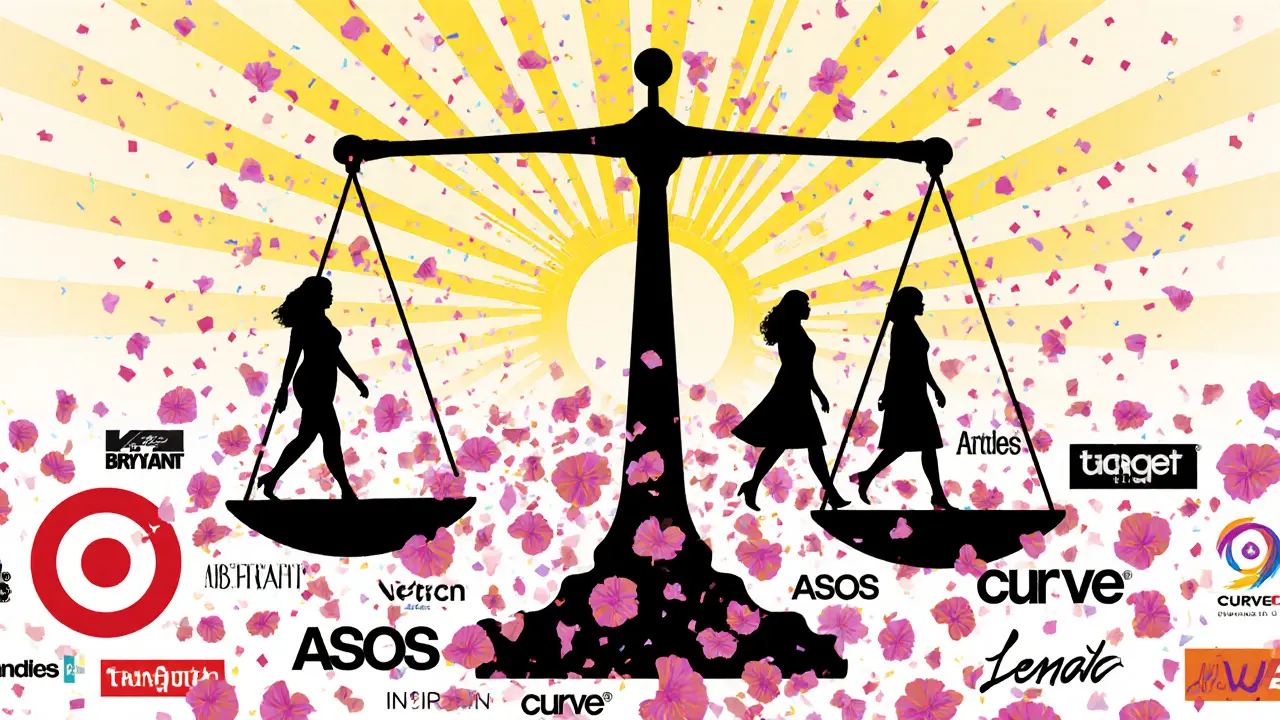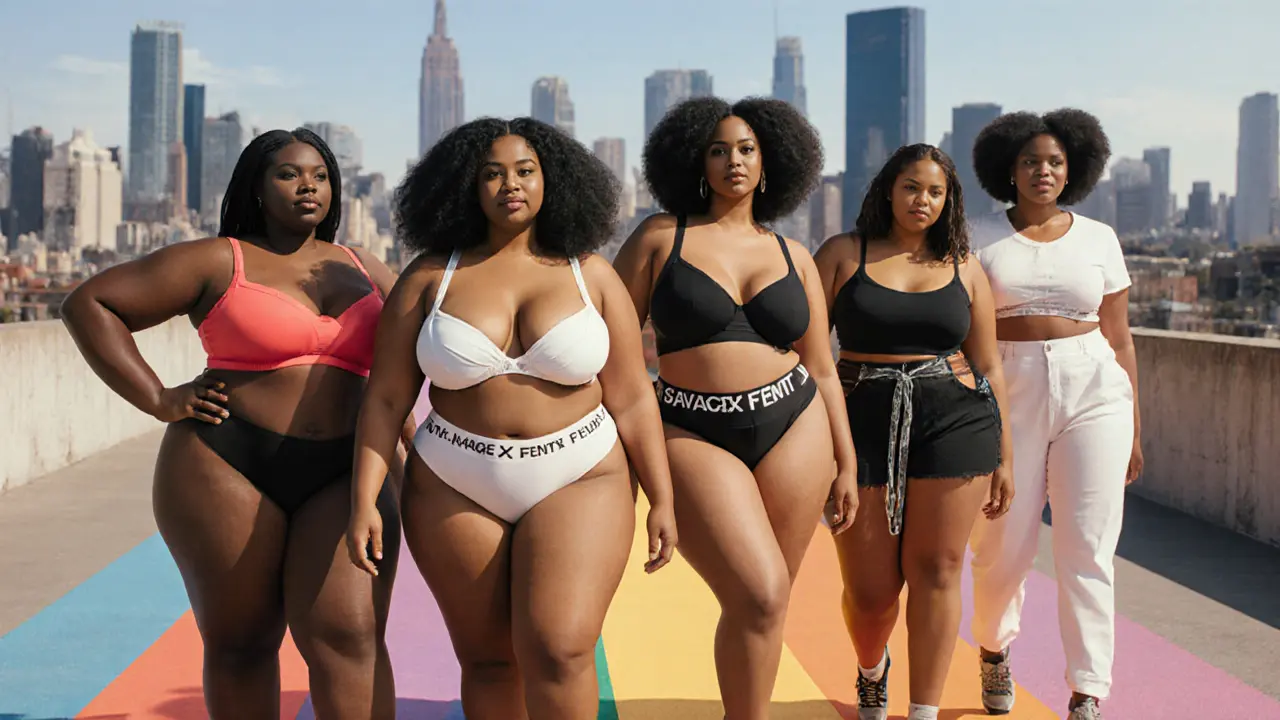You’ve seen them on billboards, in magazine spreads, on Instagram feeds-curvy, confident, powerful. Plus-size models are breaking old rules and reshaping what beauty looks like in fashion. But here’s the question everyone’s asking: What is the weight limit for plus-size models? It’s not as simple as a number on a scale. And if you’re wondering whether there’s a secret cutoff, or if agencies just pick sizes at random, you’re not alone.
Quick Takeaways
- There’s no universal weight limit for plus-size models-sizes vary by agency, country, and brand.
- Most plus-size models wear sizes 12 to 24 (US), with some going up to size 30+.
- Body measurements, proportions, and confidence matter more than weight alone.
- Major brands like Savage X Fenty, Aerie, and Lane Bryant lead the way in inclusive sizing.
- Weight is rarely listed in contracts; body shape, skin tone, and personality are key.
What Exactly Is a Plus-Size Model?
Plus-size modeling isn’t about being "big"-it’s about representing bodies that fall outside the traditional sample size range. In fashion, sample sizes typically run from 0 to 8. Once you hit size 10 or 12, you’re considered outside that norm. That’s where plus-size modeling begins.But here’s the thing: no global agency or governing body sets a single rule. The definition changes depending on who you ask. In the U.S., many agencies consider size 12 and up as plus-size. In Europe, it’s often size 14 and above. In Australia, some agencies start at size 10. It’s messy, but that’s the point-it’s evolving.
Plus-size models aren’t just tall women with curves. They come in all shapes: hourglass, pear, apple, athletic, and more. Some are 5’6”, others are 5’11”. Some weigh 180 pounds, others 250. What they all share? A presence. A way of owning space. That’s what gets them booked.
Why There’s No Official Weight Limit
You won’t find a line in any modeling contract that says, "Must weigh under 220 pounds." Why? Because weight doesn’t tell the whole story.Two women can weigh the same but look completely different because of muscle, bone structure, and fat distribution. A 200-pound woman with broad shoulders and a toned frame might look more like a traditional model than a 170-pound woman with a softer build. Agencies care about proportions, not pounds.
Take Ashley Graham-she’s one of the most famous plus-size models in the world. She’s 5’9”, wears a size 16, and weighs around 190 pounds. But she wasn’t chosen because of her weight. She was chosen because she moves like a star, her skin glows under lights, and she connects with cameras like no one else.
Agencies look for:
- Consistent measurements (bust, waist, hips)
- Proportions that fit garment samples
- Facial symmetry and expressiveness
- Ability to carry clothes well, not just wear them
Some brands even have their own sizing tiers. For example, Torrid works with models who wear sizes 14 to 30. Savage X Fenty casts models from size 12 to 24. Lane Bryant’s campaigns often feature women in sizes 16 to 22. No two brands use the same scale.
How Plus-Size Modeling Has Changed (And Why It Matters)
Ten years ago, plus-size models were rare on runways. Today, they’re front and center. In 2023, 47% of major fashion campaigns in the U.S. included at least one plus-size model, up from just 12% in 2015 (according to the Fashion Spot’s Diversity Report).Why the shift? Consumers demanded it. Women stopped buying clothes that didn’t fit their bodies. They started calling out brands that only showed thin models. Social media gave them a voice. Instagram accounts like @bodyposipanda and @i_weigh became movements.
Brands that ignored this lost money. Those that embraced it? They saw sales jump. Aerie’s #AerieREAL campaign, which used unretouched images of diverse bodies, led to a 12% sales increase in one year. Lane Bryant’s #ImNoAngel campaign broke records for engagement.
This isn’t just about inclusion-it’s about business. And that’s why the industry can’t afford to stick to old limits anymore.

What Agencies Actually Look For
If you’re thinking about becoming a plus-size model, forget the scale. Focus on these:- Measurements matter more than weight. Agencies want your bust, waist, and hip measurements. For example: 40-32-44 is common for a size 16. But if your hips are 48 and your waist is 36, that’s still in demand.
- Height isn’t everything. Runway models need to be tall. Plus-size models? Not so much. Many work in catalog, commercial, and social media roles where 5’5” to 5’10” is perfect.
- Personality sells. If you’re funny, authentic, or have a strong social media following, you’re already ahead. Brands want relatable faces, not just mannequins.
- Consistency is key. You don’t need to be a size 24 to get work. Many models fluctuate between sizes 14 and 20 and still book jobs regularly.
Some agencies even have separate divisions: "Curvy" for sizes 12-18, "Extended" for 20-26, and "Full-figured" for 28+. But even those labels aren’t fixed. One agency’s "Extended" is another’s "Curvy." It’s fluid.
Who’s Leading the Change?
These brands are setting the standard for size inclusivity:- Savage X Fenty - Rihanna’s lingerie line features models of all sizes, skin tones, and body types. No size limits. No retouching.
- Aerie - No airbrushing. Real bodies. Real stories. Their campaigns feel like your best friend posting a selfie.
- Lane Bryant - One of the first to consistently cast plus-size models in national ads since the early 2000s.
- Target - Their universal standard line includes sizes up to 3X, and they regularly feature models in those sizes.
- ASOS Curve - Offers sizes up to 24 in the UK and US, with models who look like real customers.
These aren’t token gestures. They’re long-term strategies. And they’re working.
What You Should Know Before Trying to Become a Model
If you’re thinking of stepping into this world, here’s the reality:- You don’t need to be a size 24 to get noticed. Many agencies start at size 12.
- Be prepared for rejection-but not because of your size. It’s often about look, vibe, or timing.
- Never pay an agency upfront. Legit agencies earn money when you get paid.
- Build a portfolio with natural lighting, minimal makeup, and real expressions. No filters.
- Follow agencies like Wilhelmina Models (Curvy Division), Ford Models (Plus), and IMG Models (Curvy & Plus).
And if someone tells you, "You’re too heavy," they’re not the right fit. The industry doesn’t need you to shrink. It needs you to show up as you are.

Plus-Size Models vs. Traditional Models: A Quick Comparison
| Factor | Traditional Models | Plus-Size Models |
|---|---|---|
| Typical Size Range | 0-8 (US) | 12-30+ (US) |
| Height Requirement | 5’8”-6’0” | 5’5”-5’11” |
| Primary Work | Runway, high fashion | Catalogs, e-commerce, social media |
| Measurement Focus | Waist-to-hip ratio, slim frame | Proportion, curve definition, skin tone |
| Weight Discussed? | Yes, often strictly | Rarely. Focus is on fit, not scale. |
| Brand Examples | Chanel, Dior, Gucci | Savage X Fenty, Aerie, Lane Bryant |
Frequently Asked Questions
Is there a minimum weight for plus-size models?
No. There’s no official minimum weight. Plus-size modeling starts where traditional sizing ends-usually size 12 or 14 in the U.S. What matters is how your body fits clothing, your confidence, and your ability to represent the brand’s audience.
Can you be a plus-size model if you’re not curvy?
Yes. "Plus-size" doesn’t mean only curvy. It means outside the standard sample size. Many models in sizes 14-20 have athletic, straight, or rectangular body types. Brands want diversity-not just one type of curve.
Do plus-size models have to be tall?
Not at all. While runway models need height, plus-size modeling thrives in commercial, catalog, and digital spaces where 5’5” to 5’10” is ideal. Many top plus-size models are 5’6” or shorter.
Are plus-size models paid less than traditional models?
Historically, yes-but that’s changing fast. Top plus-size models like Ashley Graham and Lizzo now earn six-figure deals. Many brands now pay equally across sizes. Pay gaps are shrinking as demand rises.
Can you be a plus-size model if you’re over 30?
Absolutely. Age isn’t a barrier in plus-size modeling. Many brands specifically seek mature models to connect with real customers. Some of the most successful plus-size models started their careers in their 30s and 40s.
Final Thought: It’s Not About the Number
The weight limit for plus-size models? There isn’t one. Not really. The real limit was never in the numbers-it was in people’s minds. For years, fashion told us beauty had to be small. Now, it’s telling us something different: beauty is diverse. It’s loud. It’s real.If you’re wondering if you fit, you already do. The industry doesn’t need you to change. It needs you to show up-and that’s the only requirement that matters.
